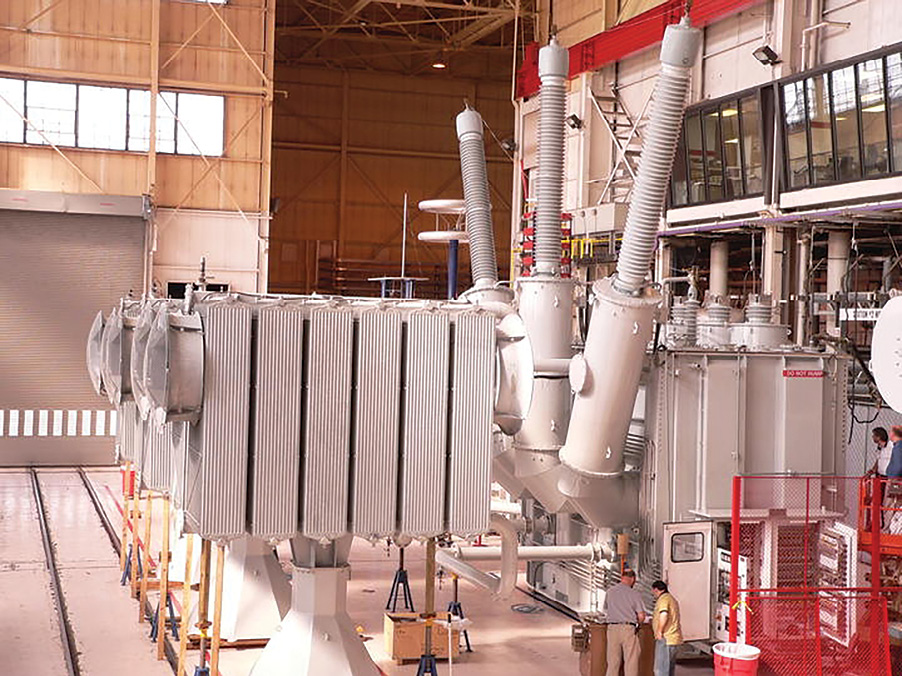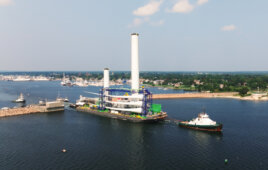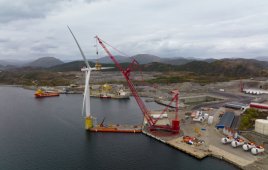A strategy for standardizing renewable-energy based generator step-up transformers can improve the profitability of wind projects.
Jesse Gill • Business Development Manager • ABB Inc • www.abb.com
RENEWABLE POWER IS THE FUTURE. Although here to stay, it comes with challenges that must be met before wind power becomes more mainstream than it is today. Besides the uncertain future of the Production Tax Credit, stalled in Congress at this writing, there are questions regarding variable and uncontrollable factors. For example, what happens when the wind simply does not blow? There are also questions about state and federal government regulations, about competing energy sources and about emerging, advanced energy-storage technologies. Finally, there are questions regarding energy efficiency, such as wind farms sited in locations so remote it is hard to get good returns on investment.
It’s clear that wind and solar in particular will play an increased role in how power is generated and distributed in the 21st century as America’s power generation landscape evolves toward more diversified sources of generation and a more decentralized set of distributed energy resources. As the wind industry works through its challenges, a key issue discussed with increasing regularity involves grid integration. How do you take increasing amounts of wind-produced power, seamlessly transmit it to load centers, and in a way that does not interfere with reliability or break the bank?
Power transformers
One key component of grid integration of renewable energy sources centers around power transformers. These are the power points on the power grid, devices that step up the wind power for high-voltage lines – mounted overhead, underground, and underwater – and send it at transmission voltage levels across thousands of miles. As the power reaches its destination, transformers step it down to lower voltages for distribution into communities and industries in the load centers, far away from the wind farms.

The large transformer is in its assembly phase at the ABB facilities in St.Louis. Bushings are the three large upward pointing connections, one for each phase. Although these transformers are not headed to wind farms, they are similar in size and function to such units.
This article will briefly discuss the standardization of a critical renewables-based Generator Step Up (GSU) transformers that can impact the profitability of wind and solar projects.
GSUs, also known as collector transformers for wind farms, are large step-up transformers that take power produced from all the wind turbines on a farm and step that voltage to a level that can be sent efficiently through high-voltage transmission lines. Generally, the higher the voltage, the greater the transmission efficiency.
Wind-farm-collector transformers, like traditional transmission transformers on the grid, have 34.5 kV secondaries, three windings, ANSI Standard impedances, along with the basic bells and whistles one would expect of such a transformer.
Collector transformers for the wind industry also differ from typical GSU transformers on thermal generation sites. Their manufacturing methods differ as well. A few of the differences include:
- Wind-farm transformers connect directly between the wind farm’s grid and transmission line, whereas a traditional GSU transformer directly connects to a generator.
- Loads on a wind farm are more variable than traditional grids, which are by design more constant. The three windings contain widely varying loads depending on the variable effects of the wind.
- The transformers may see more extreme harmonics.
- More importantly, these renewable-based GSU transformers are often produced under short lead times – much shorter than a traditional transformer timeline – and aggressive pricing, so that wind operators meet or surpass their time and cost goals.
The renewable energy environment is currently one of a quick-turnaround nature. Once a decision is made to purchase the GSU transformer, many things would ideally happen quickly. The negotiation process alone, however, can take months, an effort that hobbles the quick turnaround. A few of the many factors that must be completed in a short time frame include contracts, terms and conditions, design validations, drawing approval, third party consultants, manufacturing practices and procedures, testing, shipment, and installation.
The question that often arises to lead contracting teams is: How can we do things differently to reduce cycle time? The best solution would be to promote standardization on every level. The benefits could and should include:

Although this is one of the largest transformers shipped by ABB, modular designs assist in the transport of their necessarily large components.
Shorter delivery times: Standardization reduces lead time. The Collector Transformer, in most instances, is the critical path item to a wind project. Medium and Large Power Transformers have a typical lead-time of 35 weeks after receipt of order (ARO), sometimes more. The industry offers standard renewable transformer options that can reduce this lead time to about 20 weeks ARO and cut costs by 15% or more. This should be the goal. These transformers are built on a modular design concept, which allows for short-lead time. The modular concept allows standardization and a reduction in SCM (Supply Chain Management) by building, consigning, and stocking longer lead-time items. Doing so significantly reduces design times. A standard renewable transformer option could reduce this lead time down to 16 to 20 weeks ARO.
The claims and organization theory have already been successfully tested. ABB’s transformer plant in Alamo, Tennessee, for instance, produces the most transformer bushings in the industry. These components let energy enter and exit the transformer. The bushings team recently introduced a new line that meets the highest levels of quality and has the shortest lead-times and lowest prices – leading in most cases to a win-win situation for everybody. This group’s organization can be used as well, with minor modifications, to build collector transformers.
Shorter quotation and negotiation times: Standardization would also allow avoiding the usually lengthy Request for Proposal (RFP) process. A wind or solar farm developer would simply request the supplier to update the price and lead-time, which could be done in days, not weeks or months. Once done, the budgetary or final pricing is established and the ordering process can begin.
Drawings: With standardization, the suppler can provide outline drawings and a description of the transformer in question at the time of discussion. Pre-engineered GSU transformers include the industry standard accessories. When a developer’s organization can conform to this standard, its project will move forward more quickly.
Reliability and safety: Standardization allows improving product reliability and safety over conventional designs. Basing the complex design of a GSU transformer on the latest industry standards and materials allows delivering a unit that is reliable and safe. Components are selected to maximize the quality, as well as short lead times, while promoting the highest levels of safety. Standardization ensures this is maintained, even with short turnaround orders.
Pricing: Perhaps of most interesting benefit is that standardization reduces costs. This entire strategy is set up to improve the efficiency and quality of new power transformers. At the same time, this strategy and recent industry standards also have the effect of significantly reducing the price, perhaps by 15%. Simplicity and standardization are the names of the game for any wind operator who considers this option attractive.
The value of high standards
The design and implementation standards for generator step-up transformers are higher than ever. And these same high standards have led to a much higher level of safety on all levels as well.
ABB’s OASIS Renewable Transformer concept is an example of how these designs can benefit the wind and solar industry. The concept was designed by working closely with the industry to identify the most commonly used renewables-based transformers and combining the need to typical industry specifications. This concept includes a finite number of transformer designs that, when used, can greatly reduce cycle time and cost to renewable projects. This provides real information that can become a great advantage for a wind operator when trying to meet critical deliverables such as tax credit dates, design specifications, weights, dimensions, transport considerations, pricing and others along the way.
Today’s renewable energy generation operators can now integrate their wind or solar farms around proven transformer products that have been adjusted and designed specifically for wind farms, and around the highest standards and methods that have ever existed in the wind industry. All these advances contribute in a way that significantly improves the bottom line. WPE
Filed Under: Featured, Transformers






From your article, “The transformers may see more extreme harmonics.” So, the dirty little secret is out? If harmonics are extreme, does that mean wind plants are not in compliance with interconnection criteria? Does this mean IEEE 519 is inadequate? IEEE 519 considers or assumes that the harmonic content of a single generating unit, e.g. a 2 MW wind turbine that complies with 519 is replicated perfectly when you combine 100 of those generating units into a single collection system, replete with shuttling currents, varying impedance(s) and highly stochastic current and reactive content at each remote generating node.
It’s funny how the transformer guys are aware of the problems, and stay silent, and even eat the warranties. It’s appalling that the power electronics guys are still in complete denial that high order harmonics “don’t matter”. Avoiding the issue could be the downfall of common-sense integration of power electronic driven renewables.